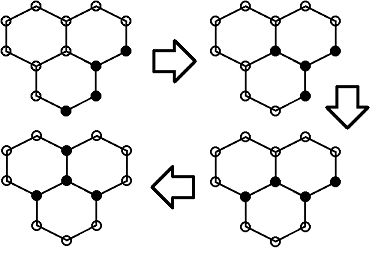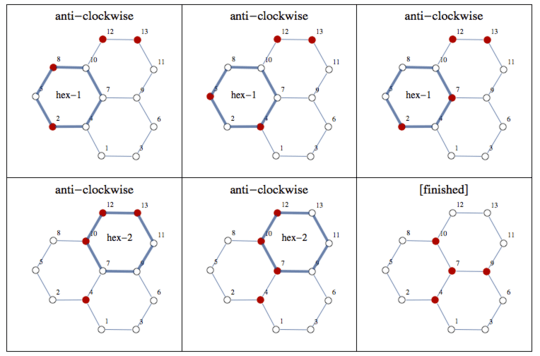4
Scenario
Little Johnny wants to play with his friends today. But his babysitter won't let him go! After a lot of begging, the heartless nanny gives him her brand new electronic puzzle and says: "If you solve the puzzle then you are free to go". Not being aware of Little Johnny's IT skills, the nanny leaves the kid alone. Rapidly, Little Johnny sends you an e-mail asking for your help. The puzzle consists of three hexagons as shown in the figure. Each vertex is painted black or white. Some of them belong to just one hexagon and some of them belong to more than one. Exactly four of them are painted black, and the other nine are white. The goal is to make the shared vertexes black by means of allowed moves: rotating a hexagon 60 degrees clockwise or counter-clockwise. Can you help Little Johnny?
Input
Input starts with an integer T, the number of puzzles to solve (1<=T<=100). T lines follow, each one having 13 binary digits, corresponding to the top-down, left to right labeling of the vertexes in the puzzle. A '0' means the i-th vertex is painted white, while a '1' means it is painted black.
output
For each test case output M on a single line, the minimum number of moves required to solve the puzzle. Then print M lines, each one describing a move in the following manner: two space separated integers H and C, the rotated hexagon (upper left is 0, upper right is 1, lower one is 2) and the direction (0 for counter-clockwise, 1 for clockwise). If there is more than one solution, any will suffice.
Example 
Input sample:
1 0000000101011
output sample:
3
2 0
2 0
1 1
source Limit
50000 Bytes
time limit
1 sec
Winning constrain
shortest code with specified time limit wins!
I leave the question for five days to decide winner future answers after five days too welcome


8Source. I'm not sure what the general feeling is about posting puzzles from other sites here, but at the very least you should give credit to the originator. – Gareth – 2012-08-31T10:23:04.690
@Gareth I like to share the knowledge with them here ,since the site which i copied was opensource community and i like to get different answers which might help me and other users of this site to think some interesting things ..if i am wrong please forgive me ..and if this is wrong notify me – BlueBerry - Vignesh4303 – 2012-08-31T10:26:26.137
3Is this a
code-golfor acode-challenge? It's currently tagged as both. As for attribution, it's just common courtesy to cite the source of something that you have copied, even if it's in the public domain – Paul R – 2012-08-31T15:57:58.887@Gareth In this case, revealing the source would also provide links to solutions. I wonder whether this may have motivated the SO not to linking to the source. – DavidC – 2012-08-31T20:43:55.150
1@DavidCarraher Possibly, but the solutions there are not required to be golfed whereas this is marked as [code-golf]. Also, if someone is waiting for a way to solve the puzzle they only need to wait for the first answer to arrive here. – Gareth – 2012-08-31T21:34:27.167
Good points to consider. – DavidC – 2012-08-31T23:51:54.767
1
Similar to http://codegolf.stackexchange.com/questions/586, http://codegolf.stackexchange.com/questions/693 , http://codegolf.stackexchange.com/questions/2478 , http://codegolf.stackexchange.com/questions/3474 , http://codegolf.stackexchange.com/questions/3524 , http://codegolf.stackexchange.com/questions/4084 , http://codegolf.stackexchange.com/questions/4619
– Peter Taylor – 2012-09-01T09:20:55.9601Wait, if he's emailing people, then he has access to the internet. which means that there's absolutely 0 reason to go outside. ever. – acolyte – 2012-09-04T16:12:36.150